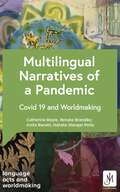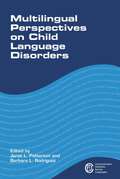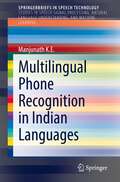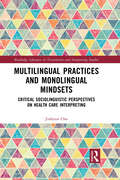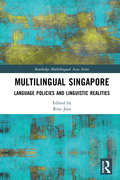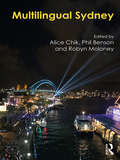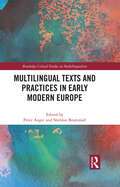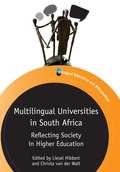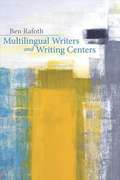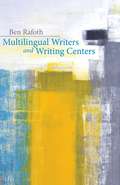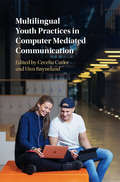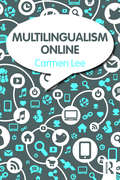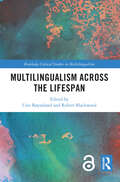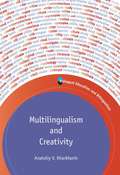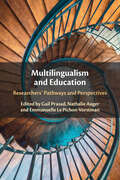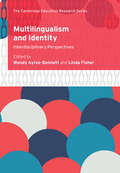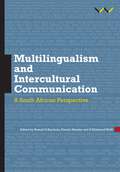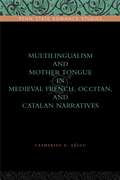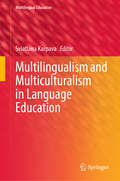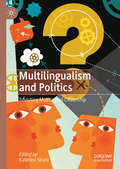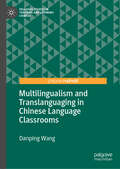- Table View
- List View
Multilingual Narratives of a Pandemic: Covid 19 and Worldmaking (Language Acts and Worldmaking)
by Various Professor Catherine BoyleWe narrate everything. We construct the world around us by telling its stories, shaping the language we use to describe what is happening to us; language that is used and adapted in the media in response to moments of crisis. This language in turn shapes how we see the world. This is what we call 'worldmaking'. When we look for solutions to problems, we so often start by telling stories to each other in our communities, stories that set a crisis in context, relate it to our historical experience, help us to understand it in the context of our local communities and contrast those stories to dominant narratives. In this way, language becomes a physical and material force in our world, through which we construct our personal, local, transnational and spiritual identities.'Worldmaking in the Time of COVID-19', the project that informs this book, was an early response to the experience of living through the COVID-19 pandemic - intended as a contribution to our collective understanding of the COVID-19 pandemic. Following comparison and analysis of over 1.1 million news articles from 117 countries in twelve different languages, this timely reflection follows the course of this investigation, with three main objectives: - to capture the languages of the early pandemic (January-April 2020); - to offer a transferable methodology for exploring world events in multiple languages; - and to share some of the key findings of researchers. Like all the volumes in the Language Acts and Worldmaking series, the overall aim is two-fold: to challenge widely-held views about language learning as a neutral instrument of globalisation and to innovate and transform language research, teaching and learning, together with Modern Languages as an academic discipline, by foregrounding its unique form of cognition and critical engagement. Specific aims are to:· propose new ways of bridging the gaps between those who teach and research languages and those who learn and use them in everyday contexts from the professional to the personal· put research into the hands of wider audiences· share a philosophy, policy and practice of language teaching and learning which turns research into action· provide the research, experience and data to enable informed debates on current issues and attitudes in language learning, teaching and research· share knowledge across and within all levels and experiences of language learning and teaching· showcase exciting new work that derives from different types of community activity and is of practical relevance to its audiences· disseminate new research in languages that engages with diverse communities of language practitioners.
Multilingual Narratives of a Pandemic: Covid 19 and Worldmaking (Language Acts and Worldmaking)
by Various Professor Catherine BoyleWe narrate everything. We construct the world around us by telling its stories, shaping the language we use to describe what is happening to us; language that is used and adapted in the media in response to moments of crisis. This language in turn shapes how we see the world. This is what we call 'worldmaking'. When we look for solutions to problems, we so often start by telling stories to each other in our communities, stories that set a crisis in context, relate it to our historical experience, help us to understand it in the context of our local communities and contrast those stories to dominant narratives. In this way, language becomes a physical and material force in our world, through which we construct our personal, local, transnational and spiritual identities.'Worldmaking in the Time of COVID-19', the project that informs this book, was an early response to the experience of living through the COVID-19 pandemic - intended as a contribution to our collective understanding of the COVID-19 pandemic. Following comparison and analysis of over 1.1 million news articles from 117 countries in twelve different languages, this timely reflection follows the course of this investigation, with three main objectives: - to capture the languages of the early pandemic (January-April 2020); - to offer a transferable methodology for exploring world events in multiple languages; - and to share some of the key findings of researchers. Like all the volumes in the Language Acts and Worldmaking series, the overall aim is two-fold: to challenge widely-held views about language learning as a neutral instrument of globalisation and to innovate and transform language research, teaching and learning, together with Modern Languages as an academic discipline, by foregrounding its unique form of cognition and critical engagement. Specific aims are to:· propose new ways of bridging the gaps between those who teach and research languages and those who learn and use them in everyday contexts from the professional to the personal· put research into the hands of wider audiences· share a philosophy, policy and practice of language teaching and learning which turns research into action· provide the research, experience and data to enable informed debates on current issues and attitudes in language learning, teaching and research· share knowledge across and within all levels and experiences of language learning and teaching· showcase exciting new work that derives from different types of community activity and is of practical relevance to its audiences· disseminate new research in languages that engages with diverse communities of language practitioners.
Multilingual Perspectives on Child Language Disorders
by Barbara L. Rodríguez Janet L. PattersonThis book investigates language disorders in children who speak languages other than, or in addition to, English. The chapters in the first section of the volume focus on language disorders associated with four different syndromes in multilingual populations and contexts. This section discusses language disorders associated with autism spectrum disorders, Down syndrome, fetal alcohol syndrome and Williams syndrome. The chapters in the second section of the book relate to language impairment in children who speak diverse languages, although the issues they address are relevant across languages and cultural contexts. The book also reviews assessment procedures and intervention approaches for diverse languages, including Bengali, Cantonese, French, Spanish, and Turkish. The volume aims to stimulate thoughtful clinical practice and further research in language disorders in multilingual populations.
Multilingual Phone Recognition in Indian Languages (SpringerBriefs in Speech Technology)
by K.E ManjunathThe book presents current research and developments in multilingual speech recognition. The author presents a Multilingual Phone Recognition System (Multi-PRS), developed using a common multilingual phone-set derived from the International Phonetic Alphabets (IPA) based transcription of six Indian languages - Kannada, Telugu, Bengali, Odia, Urdu, and Assamese. The author shows how the performance of Multi-PRS can be improved using tandem features. The book compares Monolingual Phone Recognition Systems (Mono-PRS) versus Multi-PRS and baseline versus tandem system. Methods are proposed to predict Articulatory Features (AFs) from spectral features using Deep Neural Networks (DNN). Multitask learning is explored to improve the prediction accuracy of AFs. Then, the AFs are explored to improve the performance of Multi-PRS using lattice rescoring method of combination and tandem method of combination. The author goes on to develop and evaluate the Language Identification followed by Monolingual phone recognition (LID-Mono) and common multilingual phone-set based multilingual phone recognition systems.
Multilingual Practices and Monolingual Mindsets: Critical Sociolinguistic Perspectives on Health Care Interpreting (Routledge Advances in Translation and Interpreting Studies)
by Jinhyun ChoFocusing on health care interpreting in Australia, this book examines the under-recognition of interpreting from a critical sociolinguistic perspective encompassing language, race and class.Interpreters play an important role in promoting diversity and inclusion but why is interpreting not properly recognised? Cho grapples with this question by focusing readers’ attention to developments in interpreting following increased migration in an English-monolingual Australia, a context in which other languages and speakers have been historically under-valued. Through compelling analysis and the voices of health care interpreters in Australia, this groundbreaking book explores how issues with interpreting are fundamentally issues of justice that affect minority languages and their speakers. Covering diverse professional and social spaces of interpreting, the book discovers linguistic, racial and class hierarchies embedded in English monolingualism and their impact on multilingual practices and populations. From both historical and contemporary perspectives, the book critically investigates monolingual practices from the past and tensions between enduring monolingual ideologies and multilingual realities, suggesting specific ways to overcome monolingual mindsets to make societies more inclusive.This volume will be of interest to students and scholars in interpreting studies, health communication, intercultural communication and sociolinguistics.
Multilingual Routes in Translation (New Frontiers in Translation Studies)
by Tatiana Borisova Maria SidiropoulouThis book tackles the interface between translation and pragmatics. It comprises case studies in English, Greek, Russian and Chinese translation practice, which highlight the potential of translation to interact with pragmatics and reshape meaning making in a target language in various pragmatically relevant ways. Fiction and non-fiction genres merge to suggest a rich inventory of interlingual transfer instances which can broaden our perception of what may be shifting in translation transfer. Authors use an emic approach (in addition to an etic one) to confirm results which they often present graphically. The book has a didactic perspective in that it shows how pragmatic awareness can regulate translator behaviour and is also useful in foreign language teaching, because it shows how important implicit knowledge can be, in shaping the message in a foreign language.
Multilingual Singapore: Language Policies and Linguistic Realities (Routledge Multilingual Asia Series)
by Ritu JainThis volume brings together researchers whose analysis and insights provide a comprehensive and up-to-date account of Singapore’s rich linguistic diversity. Applying a combination of descriptive, empirical, and theoretical approaches, the authors investigate not only official languages such as English, Mandarin, Malay, and Tamil, but also minority languages such as the Chinese vernaculars and South Asian and Austronesian languages. The chapters in this volume trace the historical development, contemporary status, and functions of these languages, as well as potential scenarios for the future. Exploring the tension between language policies and linguistic realities in Singapore, the contributions in this volume capture the shifting educational, political, and societal priorities of the community through its past and contemporary present.
Multilingual Subjects: On Standard English, Its Speakers, and Others in the Long Eighteenth Century
by Daniel DeWispelareIn the eighteenth century, the British Empire pursued its commercial ambitions across the globe, greatly expanding its colonial presence and, with it, the reach of the English language. During this era, a standard form of English was taught in the British provinces just as it was increasingly exported from the British Isles to colonial outposts in North America, the Caribbean, South Asia, Oceania, and West Africa. Under these conditions, a monolingual politics of Standard English came to obscure other forms of multilingual and dialect writing, forms of writing that were made to appear as inferior, provincial, or foreign oddities.Daniel DeWispelare's Multilingual Subjects at once documents how different varieties of English became sidelined as "dialects" and asserts the importance of both multilingualism and dialect writing to eighteenth-century anglophone culture. By looking at the lives of a variety of multilingual and nonstandard speakers and writers who have rarely been discussed together—individuals ranging from slaves and indentured servants to translators, rural dialect speakers, and others—DeWispelare suggests that these language practices were tremendously valuable to the development of anglophone literary aesthetics even as Standard English became dominant throughout the ever-expanding English-speaking world.Offering a prehistory of globalization, especially in relation to language practices and politics, Multilingual Subjects foregrounds the linguistic multiplicities of the past and examines the way these have been circumscribed through standardized forms of literacy. In the process, DeWispelare seeks to make sense of a present in which linguistic normativity plays an important role in determining both what forms of writing are aesthetically valued and what types of speakers and writers are viewed as full-fledged bearers of political rights.
Multilingual Sydney
by Robyn Moloney Phil Benson Alice ChikThe rise of global mobility has had a deep impact on the study of urban multilingualism. Once associated with research on minority speech communities and inner-city ethnolinguistic enclaves (Chinatowns, Little Italies, etc), it is now concerned much more with the use of multiple languages in diverse neighbourhoods across the city. In this book the authors take an innovative approach that builds on previously published work in two ways. First, it focuses on a single city and, second, it adopts a multidisciplinary approach to multilingualism. By examining the phenomenon of multilingualism in a single city from a range of perspectives this book paints a more comprehensive picture of the current dimensions of urban multilingualism. A unique feature of this book is the inclusion of contributions from scholars with expertise in education, geography, media, health communication and international studies, in addition to community practitioners. Sydney is the largest city in Australia and, on most counts, it is also among the most linguistically diverse cities in the world. As such it is an ideal site for a multidisciplinary study of urban multilingualism. The selection of 18 multidisciplinary case studies on multilingualism in Sydney, Australia represents some of the strongest and most innovative research on urban multilingualism in the world today. This book examines how multilingualism permeates institutional and everyday practice in the city, raising important questions about what a ‘multilingual city’ can and should be.
Multilingual Texts and Practices in Early Modern Europe (Routledge Critical Studies in Multilingualism)
by Sheldon Brammall Peter AugerThis collection offers a cross-disciplinary exploration of the ways in which multilingual practices were embedded in early modern European literary culture, opening up a dynamic dialogue between contemporary multilingual practices and scholarly work on early modern history and literature. The nine chapters draw on translation studies, literary history, transnational literatures, and contemporary sociolinguistic research to explore how multilingual practices manifested themselves across different social, cultural and institutional spaces. The exploration of a diverse range of contexts allows for the opportunity to engage with questions around how individual practices shape national and transnational language practices and literatures, the impact of multilingual practices on identity formation, and their implications for creative innovations in bilingual and multilingual texts. Taken as a whole, the collection paves the way for future conversations on what early modern literary studies and present-day multilingualism research might learn from one another and the extent to which historical texts might supply precedents for contemporary multilingual practices. This book will be of particular interest to students and scholars in sociolinguistics, early modern studies in history and literature, and comparative literature.
Multilingual Universities in South Africa
by Liesel Hibbert Christa van der WaltFocusing on the use of African languages in higher education, this book showcases South African higher education practitioners' attempts to promote a multilingual ethos in their classes. It is a first-time overview of multilingual teaching and learning strategies that have been tried and tested in a number of higher education institutions in South Africa. Despite language-in-education policies that extol the virtues of multilingualism, practice remains oriented towards English-only learning and teaching. In the multilingual contexts of local campuses, this book shows how students and lecturers attempt to understand their multiple identities and use the available languages to create multilingual learning environments.
Multilingual Writers and Writing Centers
by Ben RafothMultilingual writers-often graduate students with more content knowledge and broader cultural experience than a monolingual tutor-unbalance the typical tutor/client relationship and pose a unique challenge for the writing center. Multilingual Writers and Writing Centers explores how directors and tutors can better prepare for the growing number of one-to-one conferences with these multilingual writers they will increasingly encounter in the future. This much-needed addition of second language acquisition (SLA) research and teaching to the literature of writing center pedagogy draws from SLA literature; a body of interviews Rafoth conducted with writing center directors, students, and tutors, and his own decades of experience. Well-grounded in daily writing center practice, the author addresses which concepts and practices directors can borrow from the field of SLA to help tutors respond to the needs of multilingual writers, what directors need to know about these concepts and practices, and how tutoring might change in response to changes in student populations. Multilingual Writers and Writing Centers is a call to invigorate the preparation of tutors and directors for the negotiation of the complexities of multilingual and multicultural communication.
Multilingual Writers and Writing Centers
by Ben RafothMultilingual writers—often graduate students with more content knowledge and broader cultural experience than a monolingual tutor—unbalance the typical tutor/client relationship and pose a unique challenge for the writing center. Multilingual Writers and Writing Centers explores how directors and tutors can better prepare for the growing number of one-to-one conferences with these multilingual writers they will increasingly encounter in the future. This much-needed addition of second language acquisition (SLA) research and teaching to the literature of writing center pedagogy draws from SLA literature; a body of interviews Rafoth conducted with writing center directors, students, and tutors; and his own decades of experience. Well-grounded in daily writing center practice, the author identifies which concepts and practices directors can borrow from the field of SLA to help tutors respond to the needs of multilingual writers, what directors need to know about these concepts and practices, and how tutoring might change in response to changes in student populations. Multilingual Writers and Writing Centers is a call to invigorate the preparation of tutors and directors for the negotiation of the complexities of multilingual and multicultural communication.
Multilingual Youth Practices in Computer Mediated Communication
by Cecelia Cutler Unn RøynelandWith an eye to the playful, reflexive, self-conscious ways in which global youth engage with each other online, this volume analyzes user-generated data from these interactions to show how communication technologies and multilingual resources are deployed to project local as well as trans-local orientations. With examples from a range of multilingual settings, each author explores how youth exploit the creative, heteroglossic potential of their linguistic repertoires, from rudimentary attempts to engage with others in a second language to hybrid multilingual practices. Often, their linguistic, orthographic, and stylistic choices challenge linguistic purity and prescriptive correctness, yet, in other cases, their utterances constitute language policing, linking 'standardness' or 'correctness' to piety, trans-local affiliation, or national belonging. Written for advanced undergraduates, postgraduates and researchers in linguistics, applied linguistics, education and media and communication studies, this volume is a timely and readymade resource for researching online multilingualism with a range of methodologies and perspectives.
Multilingualism
by Anat Stavans Charlotte HoffmannHow do children and adults become multilingual? How do they use their languages? What influence does being multilingual have on their identities? What is the social impact of multilingualism today and how do societies accommodate it? These are among the fascinating questions examined by this book. Exploring multilingualism in individuals and in society at large, Stavans and Hoffmann argue that it evolves not from one factor in particular, but from a vast range of environmental and personal influences and circumstances: from migration to globalisation, from the spread of English to a revived interest in minority languages, from social mobility to intermarriage. The book shows the important role of education in helping to promote or maintain pupils' multilingual language competence and multilingual literacy, and in helping to challenge traditional monolingual attitudes. A clear and incisive account of this growing phenomenon, it is essential reading for students, teachers and policy-makers alike.
Multilingualism Online
by Carmen LeeBy the co-author of Language Online, this book builds on the earlier work while focusing on multilingualism in the digital world. Drawing on a range of digital media – from email to chatrooms and social media such as Facebook, Instagram, and YouTube – Lee demonstrates how online multilingualism is closely linked to people's offline literacy practices and identities, and examines the ways in which people draw on multilingual resources in their internet participation. Bringing together central concepts in sociolinguistics and internet linguistics, the eight chapters cover key issues such as: language choice code-switching identities language ideologies minority languages online translation. Examples in the book are drawn from both all the major languages and many lesser-written ones such as Chinese dialects, Egyptian Arabic, Irish, and Welsh. A chapter on methodology provides practical information for students and researchers interested in researching online multilingualism from a mixed methods and practice-based approach. Multilingualism Online is key reading for all students and researchers in the area of multilingualism and new media, as well as those who want to know more about languages in the digital world.
Multilingualism across the Lifespan (Routledge Critical Studies in Multilingualism)
by Unn Røyneland and Robert BlackwoodThis innovative collection examines key questions on language diversity and multilingualism running through contemporary debates in psycholinguistics and sociolinguistics. Reinforcing interdisciplinary conversations on these themes, each chapter is co-authored by two different researchers, often those who have not written together before. The combined effect is a volume showcasing unique and dynamic perspectives on such topics as multilingualism across the lifespan, bilingual acquisition, family language policy, language and ageing, language shift, language and identity, and multilingualism and language impairment. The book builds on Elizabeth Lanza’s pioneering work on multilingualism across the lifespan, bringing together cutting-edge research exploring multilingualism as an evolving phenomenon at landmarks in individuals’, families’, and communities’ lives. Taken together, the book offers a rich portrait of the different facets of multilingualism as a lived reality for individuals, families, and communities. This ground-breaking volume will be of particular interest to students and scholars in multilingualism, applied linguistics, sociolinguistics, and psycholinguistics.
Multilingualism and Creativity
by Anatoliy V. KharkhurinIn this monograph, Anatoliy V. Kharkhurin presents the results of his empirical investigation into the impact of multilingual practice on an individual's creative potential. Until now, the relationship between these two activities has received little attention in the academic community. The book makes an attempt to resuscitate this theme and provides a solid theoretical framework supported by contemporary empirical research conducted in a variety of geographic, linguistic, and sociocultural locations. This study demonstrates that several factors - such as the multilinguals' age of language acquisition, proficiency in these languages and experience with cultural settings in which these languages were acquired - have a positive impact on selective attention and language mediated concept activation mechanisms. Together, these facilitate generative and innovative capacities of creative thinking. This book will be of great interest not only to scholars in the fields of multilingualism and creativity, but also to educators and all those interested in enhancing foreign language learning and fostering creativity.
Multilingualism and Education: Researchers' Pathways and Perspectives
by Gail Prasad Nathalie Auger Le Pichon-Vorstman, EmmanuelleFor decades, international researchers and educators have sought to understand how to address cultural and linguistic diversity in education. This book offers the keys to doing so: it brings together short biographies of thirty-six scholars, representing a wide range of universities and countries, to allow them to reflect on their own personal life paths, and how their individual life experiences have led to and informed their research. This approach highlights how theories and concepts have evolved in different contexts, while opening up pedagogical possibilities from diverse backgrounds and enriched by the life experiences of leading researchers in the field. Beyond these questions, the book also explores the dynamic relationships between languages, power and identities, as well as how these relationships raise broader societal issues that permeate both global and local language practices. It is essential reading for students, teacher educators, and researchers interested in the impact of multilingualism on education.
Multilingualism and Identity: Interdisciplinary Perspectives (Cambridge Education Research)
by Linda Fisher Wendy Ayres-BennettThe analysis and understanding of multilingualism, and its relationship to identity in the face of globalization, migration and the increasing dominance of English as a lingua franca, makes it a complex and challenging problem that requires insights from a range of disciplines. With reference to a variety of languages and contexts, this book offers fascinating insights into multilingual identity from a team of world-renowned scholars, working from a range of different theoretical and methodological perspectives. Three overarching themes are explored – situatedness, identity practices, and investment – and detailed case studies from different linguistic and cultural contexts are included throughout. The chapter authors' consideration of 'multilingualism-as-resource' challenges the conception of 'multilingualism-as-problem', which has dogged so much political thinking in late modernity. The studies offer a critical lens on the types of linguistic repertoire that are celebrated and valued, and introduce the policy implications of their findings for education and wider social issues.
Multilingualism and Intercultural Communication: A South African perspective
by H. Ekkehard Wolff Russell H Kaschula Pamela Maseko Christine Anthonissen Bassey E AntiaAn in-depth look at the changing sociolinguistic dynamics that have influenced South African society. To date, there has been no published textbook which takes into account changing sociolinguistic dynamics that have influenced South African society. Multilingualism and Intercultural Communication breaks new ground in this arena. The scope of this book ranges from macro-sociolinguistic questions pertaining to language policies and their implementation (or non-implementation) to micro-sociolinguistic observations of actual language-use in verbal interaction, mainly in multilingual contexts of Higher Education (HE). There is a gradual move for the study of language and culture to be taught in the context of (professional) disciplines in which they would be used, for example, Journalism and African languages, Education and African languages, etc. The book caters for this growing market. Because of its multilingual nature, it caters to English and Afrikaans language speakers, as well as the Sotho and Nguni language groups _ the largest languages in South Africa [and also increasingly used in the context of South African Higher Education]. It brings together various inter-linked disciplines such as Sociolinguistics and Applied Language Studies, Media Studies and Journalism, History and Education, Social and Natural Sciences, Law, Human Language Technology, Music, Intercultural Communication and Literary Studies. The unique cross-cutting disciplinary features of the book will make it a must-have for twenty-first century South African students and scholars and those interested in applied language issues.
Multilingualism and Mother Tongue in Medieval French, Occitan, and Catalan Narratives (Penn State Romance Studies #11)
by Catherine E. LégluThe Occitan literary tradition of the later Middle Ages is a marginal and hybrid phenomenon, caught between the preeminence of French courtly romance and the emergence of Catalan literary prose. In this book, Catherine Léglu brings together, for the first time in English, prose and verse texts that are composed in Occitan, French, and Catalan-sometimes in a mixture of two of these languages. This book challenges the centrality of "canonical" texts and draws attention to the marginal, the complex, and the hybrid. It explores the varied ways in which literary works in the vernacular composed between the twelfth and fifteenth centuries narrate multilingualism and its apparent opponent, the mother tongue. Léglu argues that the mother tongue remains a fantasy, condemned to alienation from linguistic practices that were, by definition, multilingual. As most of the texts studied in this book are works of courtly literature, these linguistic encounters are often narrated indirectly, through literary motifs of love, rape, incest, disguise, and travel.
Multilingualism and Multiculturalism in Language Education (Multilingual Education #49)
by Sviatlana KarpavaThis volume focuses on multidisciplinary approaches to multilingualism, multiculturalism and language teaching and learning at (pre)primary, secondary and tertiary levels. It addresses both top-down and bottom-up perspectives on language education policies, teacher training and preparation. The book explores the needs and challenges related to education in multilingual classrooms, the relationship between parents and educators, and linguistic and cultural diversity in classrooms. It draws on the findings of research that has been conducted worldwide including in Cyprus, USA, UK, Scotland, Spain, France, Sri Lanka, Slovenia, Australia, New Zealand, Indonesia, Hong Kong, Sweden, Greece, and Italy. This book is ideal for students of (applied) linguistics, (socio)linguistics, psycholinguistics, language acquisition and education, as well as practitioners, teachers, parents, experts and researchers wishing to update their knowledge regarding multilingualism, multiculturalism, language learning, and teaching.
Multilingualism and Politics: Revisiting Multilingual Citizenship
by Katerina StraniThis edited book makes a significant contribution to the relatively under-explored field of multilingualism and politics, approaching the topic from two key perspectives: multilingualism in politics, and the politics of multilingualism. Through the lens of case studies from around the world, the authors in this volume combine theoretical and empirical insights to examine the inter-relation between multilingualism and politics in different spheres and contexts, including minority language policy, national identity, the translation of political debates and discourse, and the use of multiple, often competing languages in educational settings. This book will be of interest to students and scholars in the fields of politics, sociology, sociolinguistics, language policy, and translation and interpreting studies.
Multilingualism and Translanguaging in Chinese Language Classrooms (Palgrave Studies in Teaching and Learning Chinese)
by Danping WangThis book presents new research on Chinese as a Second Language (CSL) teaching from an ethnographic classroom study on classroom translanguaging practices that highlights the policy and pedagogical implications of adopting a creative and principled multilingual approach. Drawing on a case study from Hong Kong, it analyses naturally observed language patterns in CSL classrooms and the attitudes of students and teachers towards prescribed classroom language policies, and thereby demonstrates the importance of mixing Chinese, English and students’ home languages to achieve successful second language learning. It discusses the nature and guiding principles for classroom translanguaging research and provides research tools that will enable second language teachers to examine their own language practices. The author argues persuasively that second language teaching practices and policies must reflect the current reality of language use and the diverse learning needs of multilingual students. This book will appeal to teacher educators and researchers in fields such as second language acquisition, foreign language teaching and language policy.
